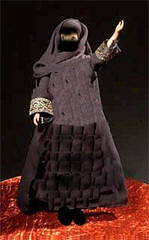My memory is good tonight, I wrote this piece on Islamic fashion about three years ago for The Voice's Woman2Woman, a now non-existent supplement...
Words: Chantelle Fiddy
Islamic fashion aficionados are amalgamating religious honour with a new style that expresses individuality while leaving the traditional look of yesteryear trailing behind…
I have never worn a veil. I need not cover any part of my body unless I so wish, as I’m neither governed to by religion or otherwise. But a growing number of the worlds female population are choosing of their free will to do so.
The rising popularity of Islam is pairing hand in hand with a new wave of fashionistas, a generation of women who, with the help of forward thinking design houses, are able to wear a traditional or liberal interpretation of the Muslim dresscode, in a modern manner. The basic rule of covering the body from head to toe still applies but age old design basics are out.
“The hijah is hip again!” Mirvat, an excited 19 year old student in Abu Dhabi told me on a recent visit. It reminded me of my own joy which accompanied the second coming of leg warmers. The hijab, like 80’s paraphernalia, had become associated with less endearing connotations, although the hijab’s reputation was somewhat bleaker than a reminder of Fame. The hijab was not only unfashionable but was seen to reflect backwardness and to an extent, militancy.
“Any colour I want I can get now and nearly every designer has a range.” And Mirvat wasn’t wrong. Even a quick scour of the local mall gave evidence not only of women out to buy, but of women covered with a dazzling array of chic, rainbow coloured clothes, teamed with the latest accessories. The current ranges blend Islamic standards with a broad appeal of Western styles, and inspiration taken from the international fashion world of fabrics. Islamic chic also makes it easier for women to work in the modern sector with hemlines rising and old looks adapted.
“People can get good cuts to their clothes, more flattering, while still having respect. The head scarf I like to wear as it signals my faith, but now you can wear them in a more trendy way” Mirvat continued. “Three, no even two years ago their wasn’t half as much choice for us…There was also a lot of trial and error when it came to which designers to follow.”
The majority of the fashion designers, who are making a constant effort to diversify the burga or the hijab, are women themselves who feel there’s not enough choice in the market.
Fashion house, Libas Design state on their blurb “women no longer have to choose culture over couture. They can now be fashionable while maintaining their culture…Our designs demonstrate that covering our bodies can be quite stylish…By intertwining today’s fashions with yesterdays modesty we can bring pride and confidence to all women…”
And it’s a big market.
The renowned Sri Munawwarah Design offer garments with a difference. Jubah are available considerably shorter than the traditional robes and complete with matching bottoms to allow freedom of movement. Dresses have come a long way too, catering for the diversity of tastes born within the community. One of their previous collections had taken inspiration from Laura Ashley. Headscarves are also available in prints, ready to be tied in many styles to give a contemporary twist.
Affluent Muslim women continue to grow ever fond of Hermes scarves as well as other prestigious designer brands including Gucci and Dolce and Gabbana.
The rapid success and expanse of the market is proving indicative of what’s to come. In the UK the number of Muslim students enrolling on fashion courses has soared in recent years. During the late nineties, the college of North West London reported 30% of the course to be Muslim. Such figures are apparent across the country.
So then, it’s somewhat ironic that while Muslim women the world over are now in a position to be in vogue, countries such as France, home of course to eclat capital Paris and six million Muslims, are banning the wearing of the hijab to schools. President Jacques Chirac has proposed a law that would codify the prohibition nationally, a “secular code” as he puts it.
But It’s Turkey that is said to have the biggest clash between haute couture and religion. Despite the country being overwhelmingly Muslim it’s also immovably secular.
Another backlash has come from Muslim women themselves. The increasing diversity in the cultural make-up in parts of the World has seen more Eastern destination succumb to Western trends. In countries like Dubai, where the previously uncommon site of a woman in shorts and a T-shirt seem to be ever blatant, many female students and young women have reverted to more traditional dress of their ancestors.
Religion and fashion have never been combined to such debate, applause or critical acclaim as now. While designers the world over have been influenced by - and borrowed from - the East for decades, now the East are claiming back what they know best - the eye awakening beauty of how best to cover up.
DICTIONARY CORNER:
HIJAB – Literally it means concealing, protecting, and is used to refer to the head cover/scarf, of the Muslim male or female.
HUJUB – Cover, wrap, a woman’s veil.
JILBAAB – A loose fitting garment covering the entire body, so that the shape of the woman is defined but hidden, including the head, face and hands.
NIQAB – A face veil worn together with the hijab.
Tuesday, 17 October 2006
How Best To Cover Up
Subscribe to:
Post Comments (Atom)









No comments:
Post a Comment